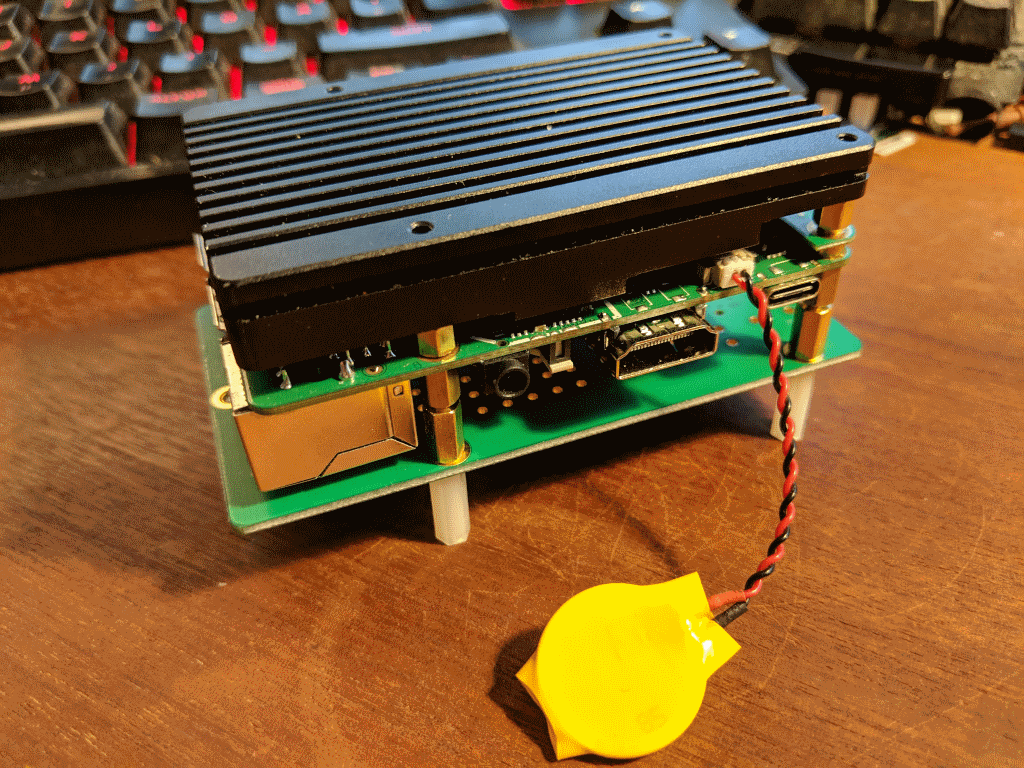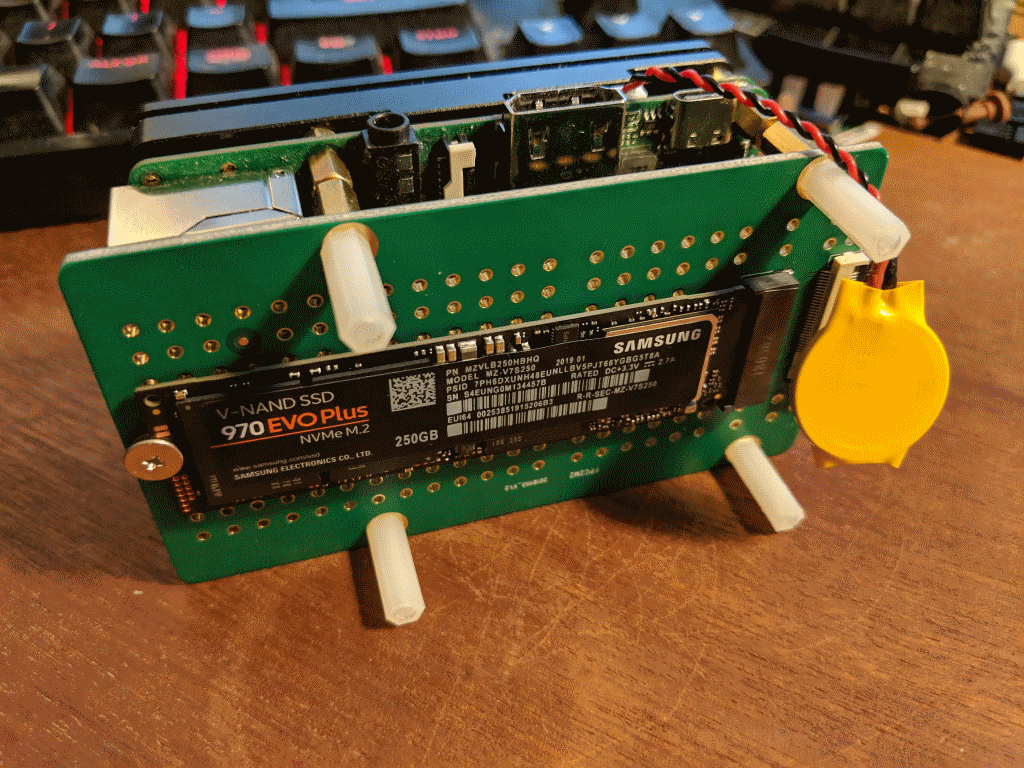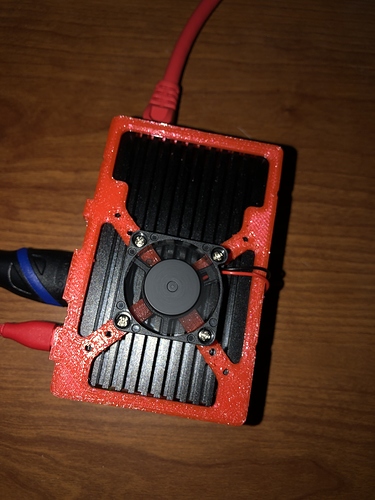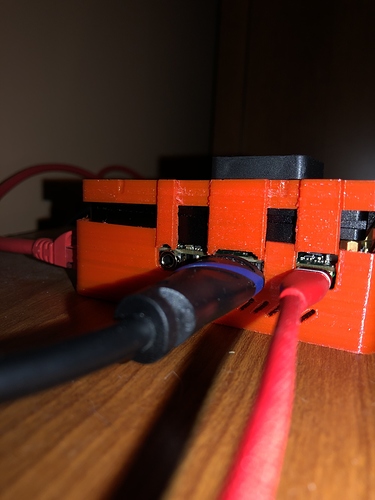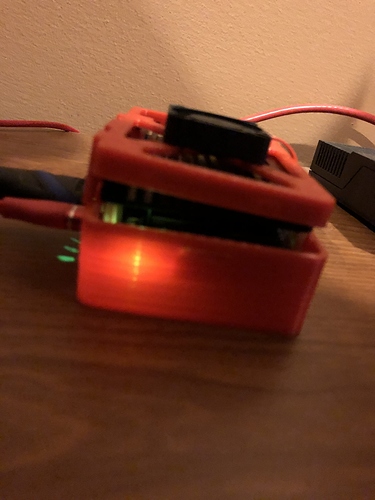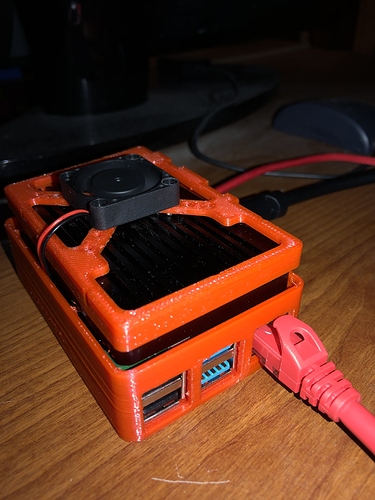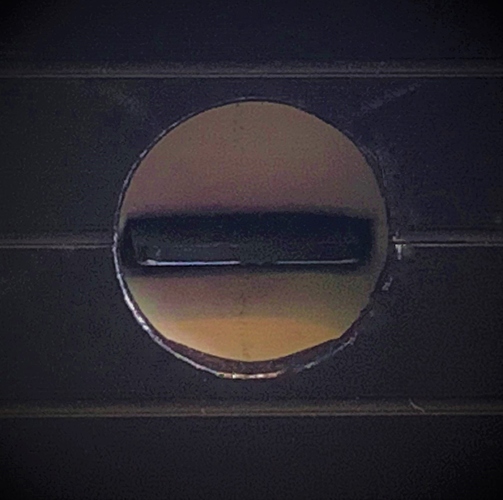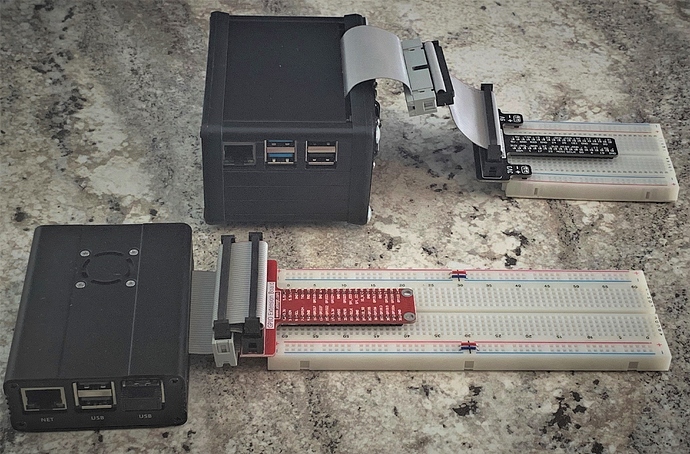I purchased a tiny CPU fan and connected it to the +Ve and GND Pins on the GPIO. It is able to generate sufficient amount of air current to blow away the heat around the heat sink. As you mentioned, finding a case for enclosing the fan, board along with the heat sink is becoming a little difficult. I am thinking of getting an aluminium box and place the whole assembly inside that.
Large Heatsink with Case
I’d be happy to purchase a case from Radxa as well and wait the 3 weeks for it to ship to the USA if one were offered. I’m thinking something similar to the case that looks to come with the Odroid N2 but perhaps with a small fan.
I had the same problem of a new but naked rock pi 4 with a large heatsink, so I made a case you can print with a 3d printer. Maybe it’s sufficient for your purpose…
Looks nice! Any chance to maybe add a bit to the bottom to support a 40mm small fan to help with cooling even more? I’ve used this fan before on other arm devices and it works well:
xaxas,
Wow that looks amazing … I don’t have access to a 3D printer …
Hopefully this will get picked up and put into production via AllNet or a 3rd party via amazon …
Need a decent case and yours look good!!!
This looks perfect! We can make a sample out.
I’m glad you like it!
It would be nice to see some people using it. But I’m not sure about the handling and fitting of it, as long as only one piece exists  But I’m ready for reworks…
But I’m ready for reworks…
@xaxas the case looks good in any case, but my RockPi 4 doesn’t fit into it and I personally wouldn’t enclose the heat sink either.
It would be a good idea for Radxa to provide a case for sale designed to work with the large heat sink and with a fan or at least holes to mount one.
Wow, thank you for testing the case. The larger part was meant to be the bottom part wich is only connected to the top part via clips. Maybe it’s not intuitive working top down respectively it’s badly described to couple the RockPi4 an the top cover first.
Can you perhaps publish more views of the case?
I’ll take some more photos tonight
I’m waiting for my Rock Pi 4B w/Heatsink to arrive, at any moment. I was also wondering what to do about a case. Looks like there is also be a problem with the SSD card obstructing the GPIO header and internal cooling fan. I’m going to see if the SSD card will mount on the opposite side of the heatsink, with a divider on standoffs. If so, perhaps the top part of a layered RPi case w/fan will cover the SBC, while allowing access to the GPIO header.
Thank you for the photos.
Wood is the way forward … 
I wanted to extend my approach to the possibility of attaching the NVME carrier.
Since I don’t own this extension I wanted to ask, if anyone can provide the dimensions of the carrier pcb and the other parts (including ribbon cable). A 3d model would be even better 
thanks a lot
The M.2 extender board is 87 mm long X 55 mm wide.
BTW, ALLNET says they have started production of an aluminum case, but I haven’t seen it yet.
The following is what I came up with after much thought, searching the web for suitable project boxes, and metalwork. Unfortunately, I am unable to upload the document as an attachment, so formatting is lost, but I hope the information is helpful for others.
Aluminum Rock Pi 4B Case
First, you see the typical Raspberry Pi arrangement of connectors on the top half of the aluminum case, while the bottom half has been expanded to accommodate the Rock Pi 4B’s large heatsink and SSD.
The SSD is mounted beneath the heatsink, but separated from the heatsink with standoffs. This positions the SSD it at the lowest level inside the case to avoid whatever ambient heat may be rising from the heatsink.
Beneath the ethernet and USB ports, the heatsink is in direct physical contact with the aluminum case, which effectively creates an extended heatsink.
The FPC cable for the M.2 extender board requires extra room beyond the end of the main board and heatsink, which means the microSD slot is located further inside the case, making it more difficult to access, plus microSD cards are more easily dropped inside the case.
A short length of ½” diameter PVC pipe, cut lengthwise, and mounted horizontally solves this issue by forming a catch tray and precise guide for accessing the slot. Tweezers are still required for insertion and removal, which is less frequent when booting the Rock Pi 4B from the eMMC module.
With the catch tray’s white color, it is much easier to see the microSD slot. A hole located near the power LED illuminates the interior of the catch tray creating a nice soft green glow when power is on.
The aluminum case is cooled with dual internal Raspberry Pi fans, with protective grills that make the Rock Pi 4B ready to roll. Junior can carelessly grab it up and stuff it into a backpack, with no worries.
The dual fans are positioned to force air directly into the space between the large heatsink and the M.2 extender board. The hot air is pushed out through connector ports and vent holes.
The fans are powered from GPIO pins 4 & 6. A custom ribbon cable extends the 5 VDC & ground wires to compatible connectors and splitters for powering both fans while the GPIO header is being utilized by a ribbon cable during project development.
The top panel of the case can slide away from the fans, creating a gap for either the GPIO extender cable or a standard 40 pin ribbon cable to slip through for communicating with the external world. By using the optional GPIO extender ribbon, the top panel can remain in place to protect the Rock Pi 4B board and to maintain consistent airflow. It is no longer necessary to get inside the case, just to disconnect the ribbon cable.
There’s also less risk of breaking the breakout ‘T’ on the solderless breadboard because all the connect/disconnect stresses are at the middle of the ribbon cable, not at the more fragile endpoints. The female 40 pin mid-cable connector also allows for ‘hot-plugging’ of projects, without powering down.
Above are similar configurations of the Rock Pi 4B aluminum case and the ($14.90) Raspberry Pi 3B+ aluminum case, both utilizing GPIO extender ribbon cables connected to solderless breadboards.
My objective was to make the case as small as possible, without losing functionality. But, the previously illustrated Rock Pi 4B aluminum case is less than half the size of the original aluminum project box from which it was made.
The unused portion of the original box can be a 100mm extension of the Rock Pi 4 case along the side of the cooling fans to include additional components and their electrical connections. No more grommets with silicone sealant.
The GPIO extender cable could be used for stacking RPi HATS or omitted if it is more desirable to connect devices directly to a few GPIO pins. Either way, M-F patch wires can be used to extend the 5 VDC power to the dual cooling fans, which have moved the far end of the extended aluminum case. With it being fully enclosed the airflow is forced onto the Rock Pi 4B, just as before. The air simply travels a little further to get there.
With the Rock Pi 4B being fully contained inside this case, the cutouts (except for the USB-C power connector and fans) could be omitted entirely for an outdoor headless configuration, safe from the elements.
Parts List:
30mm Black Fan Finger Grill (4 Packs)
$7.99
2.5mm X 0.45 HSS Taper and Plug Tap M2.5 X 0.45mm Pitch
$11.99
$43.64 Parts Total (aluminum case, dual fans, dual grills, 1 x Male + 1 x Female 40 pin IDC connectors for GPIO extender ribbon cable)
Issues
• The M2.5 mounting holes on the large heatsink were only threaded on one side. In order to use them to securely mount the M.2 extender board, it was necessary to purchase M2.5 taper and plug taps, which are smaller than those being sold in most American hardware stores. I could only order them from Amazon.
I am an experienced machinist and knew to be extra careful to avoid breaking them off because they are so small (I suspect this is the reason the holes have not been tapped all the way through by the mfr.) I also took extra care to clean out the aluminum particles afterwards, which could lead to shorted circuits.
For the convenience of others, I have requested that Radxa extend the M2.5 threads completely through the heat sink’s mounting holes so that they can be utilized from both sides.
• I could not have built this case without the new, shorter M.2 extender board. Thanks to Radxa for making that modification. However, instead of the end of the board being in line with the USB and ethernet connectors, it needs to be in line with the board and heatsink. The RPi connectors are intentionally designed to extend beyond the SBC in order to fit through cutouts in a case. This specific aluminum project case has a ribbed interior for mounting circuit boards. The connectors were only able to be flush with the case’s interior by filing away the ribs around them.
Then, I used a Dremel tool to modify the mounting holes on the M.2 extender board into slots to allow the M.2 extender board to slide back in line with the heatsink. This also permitted the heatsink to be in direct contact with the aluminum case, improving heat loss.
I have requested that Radxa shift the mounting holes by 2mm away from the end with the M.2 connector on future M.2 extender boards for better heat loss and appearance.

